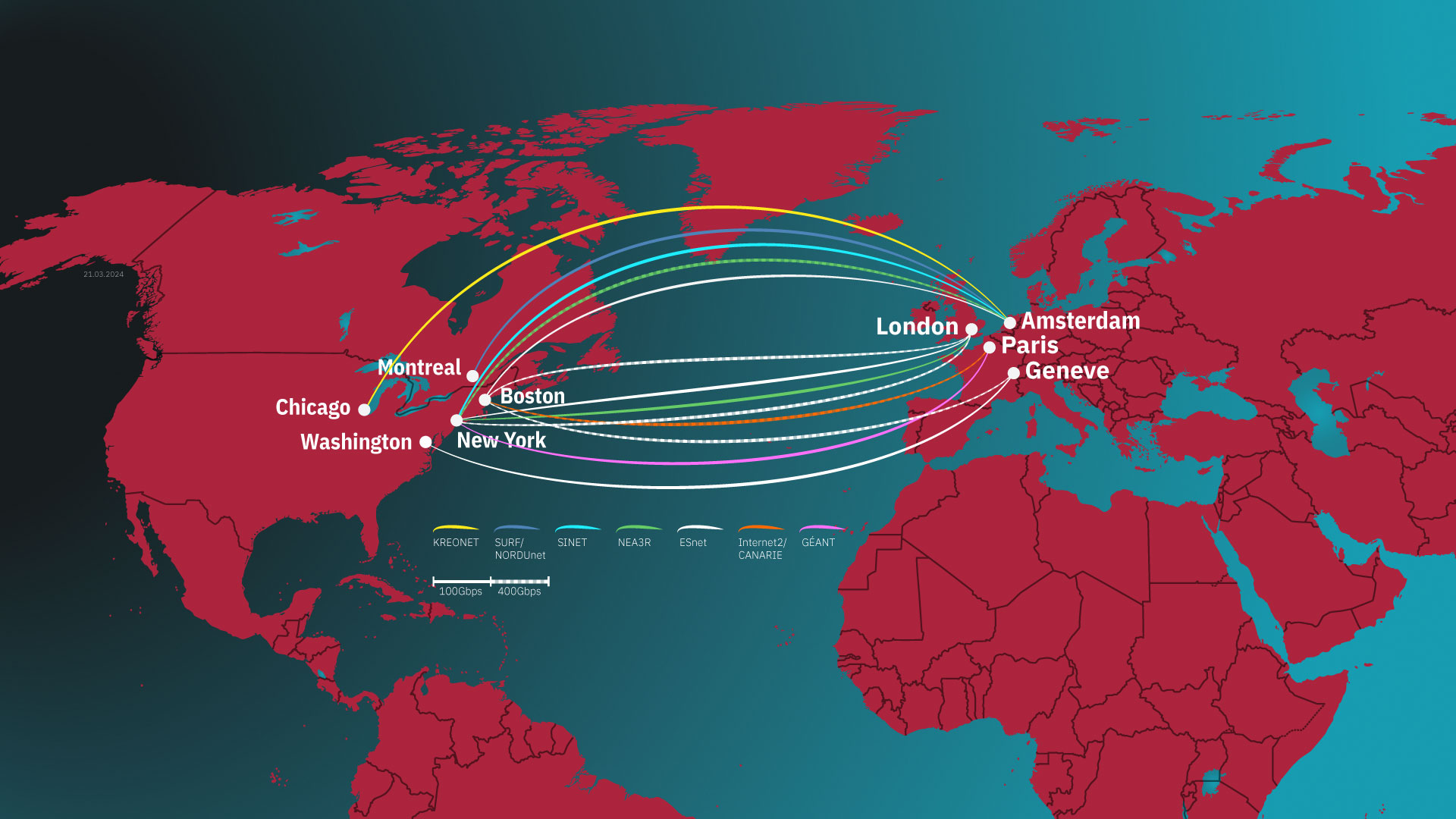The Networks for European, American, African, and Arctic Research (NEA3R) project, led by International Networks at Indiana University (IN@IU), announced today a major upgrade to its trans-Atlantic connectivity and a new collaboration with Internet2 that will significantly enhance U.S. researchers’ ability to seamlessly transfer data across the globe. NEA3R is an NSF-funded initiative that provides advanced networking services, measurement and monitoring tools, and targeted science engagement in support of international research and education.
Contributing to and Benefiting from International Collaboration
The newly upgraded circuit will connect the Internet2-operated Manhattan Landing (MAN LAN) Global Exchange Point in New York with the Netherlight Global Exchange Point in Amsterdam at 400Gbps and serve as a key contribution to the Advanced North Atlantic (ANA) consortium. The ANA is a collaborative global networking initiative composed of leading international networking organizations: CANARIE (Canada), Internet2 (U.S.), GÉANT (Europe), KREONET (South Korea), NORDUnet (Nordic countries), SURF (Netherlands), ESnet (U.S. Department of Energy), SINET (Japan), and NEA3R (U.S.). These organizations work collectively to design, procure, and operate a robust, high-performance, resilient trans-Atlantic network infrastructure essential for global science and education. ANA members contribute circuits to and share the use of an integrated system that forms the backbone of research and education connectivity between the U.S. and Europe, which will now deliver 2.7Tbps.

Expanding NEA3R
The NEA3R project includes investigators from GÉANT, the pan-European network for research and education; NORDUnet, which interconnects the five Nordic countries; and the UbuntuNet Alliance, providing connectivity for Eastern and Southern Africa. Over the past two years, IN@IU has worked closely with Internet2—a nonprofit organization providing high-performance network services, cloud solutions, and research support across the U.S.—to align international infrastructure investments and ensure coordinated support for users at U.S. universities, research institutions, and government agencies. As part of this continued collaboration, Chris Wilkinson, Senior Director of Network Infrastructure and Operations at Internet2, will join the NEA3R project as a co-Principal Investigator, formalizing the collaboration and strengthening their shared commitment to addressing current and future international connectivity needs.
“We are pleased to join the NEA3R collaboration, contributing Internet2’s 400G trans-Atlantic capacity, measurement data, and distributed computing systems to the project,” said Chris Wilkinson, Senior Director of Network Infrastructure and Operations at Internet2. “By building scalable, resilient, high-speed international connectivity, we’re empowering transformative science across disciplines – from physics to astronomy and climate science to global health – enabling researchers to achieve new discoveries and breakthroughs.”
Enhancing Global Research
The upgraded 400G link will provide researchers with improved access to data from major international research projects. For example, two of the telescopes in the Event Horizon Telescope (EHT) —an international collaboration that captured the first-ever images of black holes—are located in Europe. The increased capacity will enhance the transfer of large observational datasets back to the U.S. for analysis. Additionally, the upgraded link will facilitate near real-time satellite data sharing between the National Oceanic and Atmospheric Administration (NOAA) and the European Organisation for the Exploitation of Meteorological Satellites (EUMETSAT). These agencies rely on continuous data transfers from weather and climate satellites to monitor environmental conditions, predict extreme weather events, and study climate change. With the increased capacity, researchers will gain faster, more reliable access to these datasets, improving the efficiency and accuracy of scientific analysis.
Supporting Indiana University Research
The upgrade will also provide significant value to Indiana University’s research efforts, enhancing projects that transfer data between Africa and the U.S., including the Academic Model Providing Access to Healthcare (AMPATH). AMPATH is a consortium of hospitals led by IU that facilitates healthcare delivery in Kenya. NEA3R supports data transfers between AMPATH sites in Africa and partners in the U.S., with the 400G link enabling faster, more efficient sharing of critical healthcare data across Africa, Europe, and the U.S. The upgraded infrastructure will also improve access to large datasets from global, distributed science facilities, such as the Large Hadron Collider (LHC) in Geneva and the European Bioinformatics Institute in the UK, expanding IU researchers’ ability to participate in global scientific discovery.
“The NEA3R project’s upgrade to 400GB and addition of Internet2 as a Principal Investigator will further align US investments in trans-Atlantic research and education connectivity with the science and engineering needs of the community we serve.” said Edward Moynihan, Principal Investigator of NEA3R and leader of International Networks at Indiana University. “We are excited to continue working within NEA3R and with the Advanced North Atlantic consortium to define and implement the next generation of global collaborative networking systems. We strongly believe these investments and partnerships are transforming how scientists and educators around the world connect, collaborate, and drive discovery.”

